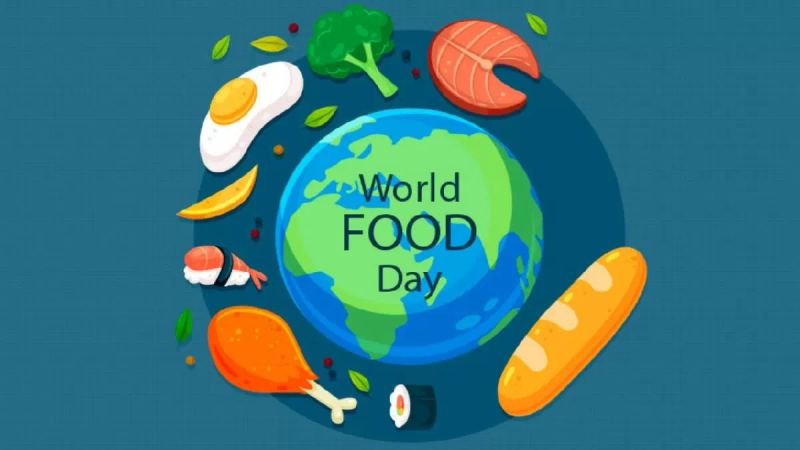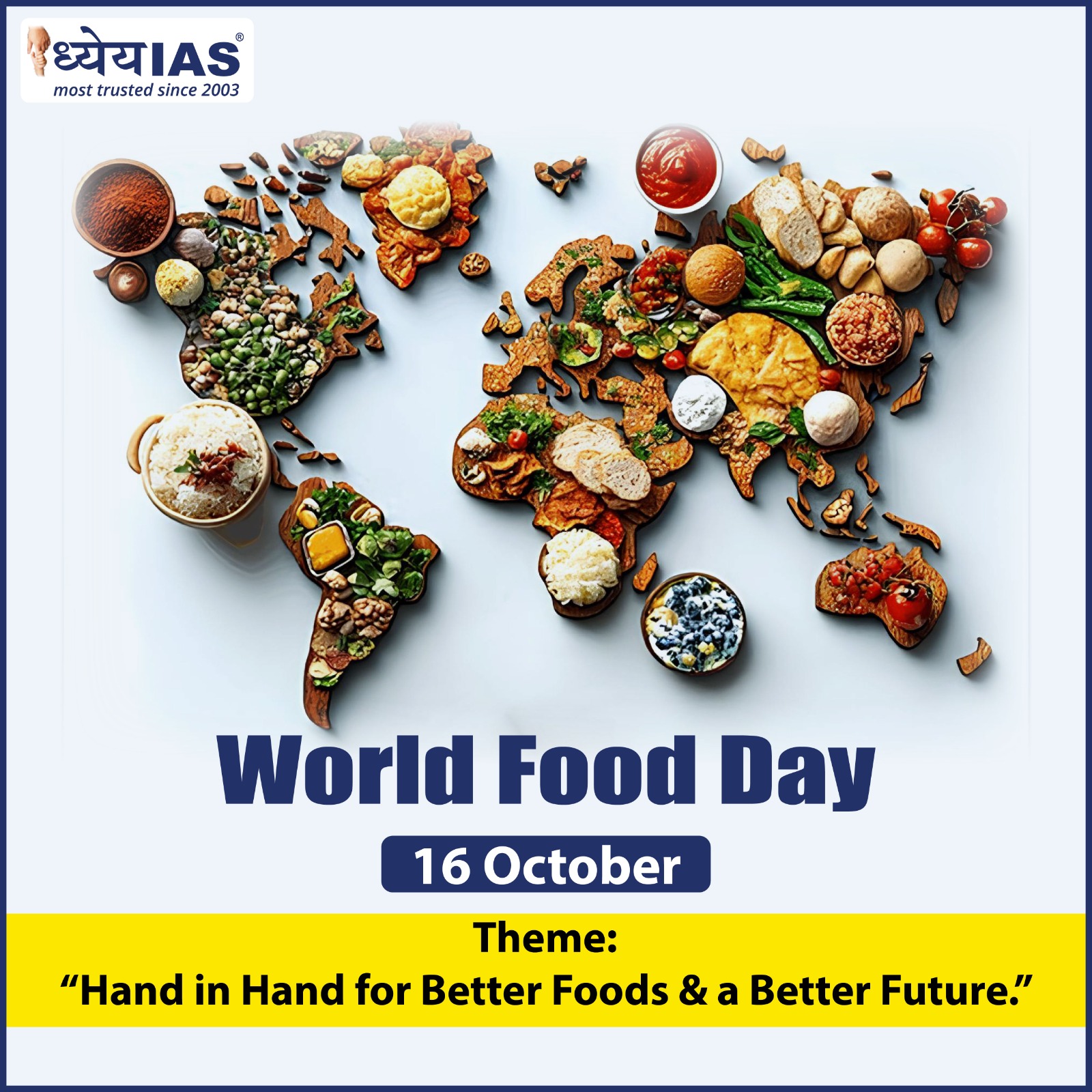Better Food, Better Future: A New Direction for Global Food Governance
Context:
On 16 October 2025, the world observes World Food Day, led by the Food and Agriculture Organization (FAO) of the United Nations, which marks 80 years of its global mission to end hunger. This year’s theme “Hand in Hand for Better Foods and a Better Future” focuses on collaborative efforts to transform global food systems through the Hand-in-Hand Initiative (HIH). The theme is a reminder that collective partnerships among governments, farmers, businesses, and communities are essential to build resilient, equitable, and sustainable food systems, especially amid climate change, conflicts, and economic instability.
Global Hunger: A Persistent Challenge
-
- Although the world produces enough food to feed its 8.2 billion people, hunger continues to affect millions. In 2024, about 673 million people faced hunger at some point during the year. The World Food Programme (WFP) reports that regions such as Gaza, Sudan, and Haiti host nearly 1.9 million people enduring catastrophic hunger.
- Globally, 733 million people remain undernourished, while 2.8 billion cannot afford a healthy diet due to rising food prices and living costs. The imbalance is stark — food surplus and waste coexist with severe deprivation. Africa and West Asia have witnessed major setbacks due to conflict and extreme weather events, while the Ukraine war and global supply chain disruptions have driven up food prices by 14 percent, pushing 71 million people into poverty.
- Although the world produces enough food to feed its 8.2 billion people, hunger continues to affect millions. In 2024, about 673 million people faced hunger at some point during the year. The World Food Programme (WFP) reports that regions such as Gaza, Sudan, and Haiti host nearly 1.9 million people enduring catastrophic hunger.
Understanding Food Security:
According to the FAO, food security exists when all people, at all times, have physical, social, and economic access to sufficient, safe, and nutritious food to meet their dietary needs and preferences for a healthy life.
Food security has four key pillars:
1. Availability – Sufficient quantities of food must be consistently produced and supplied.
2. Access – People must have the financial and physical means to obtain food.
3. Utilization – Food must be nutritious, safe, and used effectively, supported by sanitation and healthcare.
4. Stability – Access and availability should not fluctuate due to crises or seasonal shocks.
When any of these dimensions are compromised, food insecurity arises. It may be chronic (long-term, due to poverty or weak systems) or transitory (short-term, caused by droughts, floods, conflicts, or price surges).
Global Food Systems Under Stress:
-
- Agrifood systems provide livelihoods to nearly 1 billion people and contribute one-third of global greenhouse gas (GHG) emissions. Climate change, unsustainable farming, and resource depletion are exerting intense pressure on them.
- The Intergovernmental Panel on Climate Change (IPCC) notes that rising temperatures and unpredictable rainfall have already lowered crop yields in regions like South Asia. Shifts in planting cycles, pest outbreaks, and water scarcity are making agriculture more vulnerable.
- Beyond climate, economic shocks, pandemics, and trade disruptions further threaten food stability. The COVID-19 crisis exposed the fragility of global supply chains, while wars and protectionist trade policies have worsened inequality in food access.
- Agrifood systems provide livelihoods to nearly 1 billion people and contribute one-third of global greenhouse gas (GHG) emissions. Climate change, unsustainable farming, and resource depletion are exerting intense pressure on them.
Sustainable and Regenerative Practices:
-
- Sustainability in agriculture is no longer optional — it is essential. Regenerative agriculture is gaining traction for its ability to restore soil health, enhance biodiversity, and increase productivity while lowering emissions.
- Research also highlights the importance of polycentric governance, where public institutions, private enterprises, and local communities work together. A 2024 review of governance models found that hybrid, participatory frameworks create more resilient and inclusive food systems than top-down approaches.
- Furthermore, a 2025 study in Frontiers in Sustainable Food Systems emphasised systems-thinking approaches — mapping interconnections within food systems to identify leverage points like agroecological transitions that improve nutrition and biodiversity.
- Sustainability in agriculture is no longer optional — it is essential. Regenerative agriculture is gaining traction for its ability to restore soil health, enhance biodiversity, and increase productivity while lowering emissions.
Innovation and Collaboration in Food Systems:
Technological and collaborative innovations are reshaping the way food systems function. A review of over 500 research studies on sustainable food supply chains found a strong post-2020 trend toward collaboration, digital traceability, and circular economy models.
-
- Blockchain and traceability tools improve transparency and reduce food losses.
- Circular economy models repurpose agricultural waste into animal feed or bioenergy.
- Co-creation and fair-trade partnerships enhance income distribution and empower local producers.
- Blockchain and traceability tools improve transparency and reduce food losses.
However, most such advancements remain concentrated in high-income regions, while developing countries continue to face the heaviest hunger burden. This underlines the need for global cooperation and capacity building in the Global South.
FAO’s Hand-in-Hand Initiative (HIH)
The FAO’s Hand-in-Hand Initiative, launched in 2019, is a flagship global programme that embodies this year’s World Food Day theme. It aims to accelerate the transformation of agri-food systems that are inclusive, climate-resilient, and sustainable.
The HIH directly contributes to:
-
- SDG 1 – No Poverty
- SDG 2 – Zero Hunger
- SDG 10 – Reduced Inequalities
- Climate Resilience Goals
- SDG 1 – No Poverty
Operating in 80 countries across Africa, Asia, Latin America, and the Pacific, HIH uses advanced geospatial and socioeconomic analysis to identify high-impact zones for agricultural investment.
Through its Investment Forums, the initiative mobilises public and private financing to strengthen value chains, improve nutrition, and support climate adaptation. Projects in Peru, Ethiopia, and the Pacific Islands have enabled women and youth farmers to diversify crops, improve incomes, and access sustainable markets — while conserving biodiversity and reducing food loss.
Food Security in India: Regional Insights:
India presents a paradox — it is self-sufficient in food production yet faces uneven food security across regions and communities. The key challenges lie not in availability but in access, distribution, and nutrition.
1. North-Western Region
-
-
- States: Punjab, Haryana, Western Uttar Pradesh
- High productivity and strong procurement systems ensure food availability.
- Challenges include monocropping, soil degradation, and falling groundwater levels.
- States: Punjab, Haryana, Western Uttar Pradesh
-
2. Eastern and Central India
-
-
- States: Bihar, Odisha, Jharkhand, Chhattisgarh, West Bengal
- High agricultural potential but poor infrastructure and weak markets.
- Tribal and rural communities suffer from chronic undernutrition despite fertile land.
- States: Bihar, Odisha, Jharkhand, Chhattisgarh, West Bengal
-
3. Western and Dryland Regions
-
-
- States: Rajasthan, Gujarat, Maharashtra
- Arid conditions and water scarcity lead to low food availability.
- Seasonal migration and recurrent droughts affect household food stability.
- States: Rajasthan, Gujarat, Maharashtra
-
4. Southern States
-
-
- States: Tamil Nadu, Kerala, Karnataka, Andhra Pradesh
- Strong governance, diversified crops, and better nutrition indicators.
- Kerala and Tamil Nadu lead in nutrition-sensitive policies and PDS efficiency.
- States: Tamil Nadu, Kerala, Karnataka, Andhra Pradesh
-
5. North-East India
-
-
- Mountainous terrain and poor connectivity increase transport costs.
- Shifting cultivation and climate sensitivity create seasonal food shortages.
- Mountainous terrain and poor connectivity increase transport costs.
-
6. Urban India
-
-
- Rising urban poverty and food deserts in informal settlements.
- Dependence on markets makes food access vulnerable to inflation and job insecurity.
- Rising urban poverty and food deserts in informal settlements.
-
Economic and Policy Dimensions:
India’s food security is closely linked to economic policy.
-
- Public Distribution System (PDS) under the National Food Security Act (NFSA), 2013, covers 75% of rural and 50% of urban populations, ensuring subsidized grains to over 800 million citizens.
- Minimum Support Prices (MSP) stabilize farm incomes and national stock levels but create regional imbalances by favouring rice and wheat over millets or pulses.
- Income and employment schemes like MGNREGA and PM-KISAN improve purchasing power, strengthening access to food.
- Nutrition-focused programmes such as POSHAN Abhiyaan, Mid-Day Meal Scheme, and ICDS link food access with health outcomes.
- Public Distribution System (PDS) under the National Food Security Act (NFSA), 2013, covers 75% of rural and 50% of urban populations, ensuring subsidized grains to over 800 million citizens.
However, inefficiencies, leakages, and regional disparities persist. A more decentralized, data-driven, and nutrition-sensitive approach is needed to address localized vulnerabilities.
Climate, Technology, and Food Resilience:
Building future-ready food systems requires climate-smart agriculture, disaster resilience, and technological integration.
-
- Pradhan Mantri Fasal Bima Yojana (PMFBY) provides crop insurance against natural calamities.
- Geospatial tools (GIS, Remote Sensing, GPS) help identify vulnerable zones, monitor yields, and plan interventions.
- Investments in irrigation, cold chains, and digital marketplaces (e-NAM) reduce losses and stabilize markets.
- Pradhan Mantri Fasal Bima Yojana (PMFBY) provides crop insurance against natural calamities.
Conclusion:
As the FAO marks 80 years of service, World Food Day 2025 reminds the world that ending hunger is not only about producing more food but about ensuring fair access, sustainable practices, and shared responsibility.
| UPSC/PSC Main Question: The global food security crisis is not just about food availability but also about equitable access, affordability and nutritional quality. Discuss. Also, how can sustainable and resilient food systems provide solutions to this challenge? |








